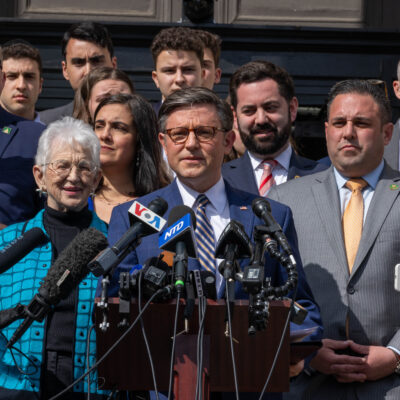Gen. Kurilla offers details on plan for Gaza aid pier
The U.S. Central Command head said U.S. ships would ferry aid supplies to the Gaza shore, but U.S. troops would not set foot inside the enclave

Jabin Botsford/The Washington Post via Getty Images
Lt. Gen. Michael Kurilla, nominee to be commander, United States Central Command, testifies during a Senate Armed Services Committee confirmation hearing on Capitol Hill on Tuesday, Feb. 08, 2022, in Washington, D.C.
Gen. Michael “Erik” Kurilla, the top U.S. commander in the Middle East, revealed new details regarding the Biden administration’s plan to construct a humanitarian pier in Gaza. Kurilla said, testifying to the House Armed Services Committee on Thursday, that U.S. troops would not set foot inside the enclave but revealed that U.S. personnel and ships would ferry supplies to the Gaza shore.
He explained that the construction process will involve building both a floating pier at sea and a pier secured to the beach in Gaza. Aid would be offloaded from ships at the floating pier, then transferred by U.S. Army boats to the shore in Gaza.
But he said that U.S. troops will never set foot inside Gaza and said that protecting U.S. personnel is a “top priority.”
Top military personnel are currently in the region working with partner countries to determine the details of how U.S. forces will be protected, the logistics of building the pier on the shore in Gaza and how humanitarian aid will be distributed after it is offloaded, Kurilla told lawmakers. He declined to provide further details in an unclassified setting.
He said that the U.S. does not plan to rely on Israel to distribute aid, either from the port or through land crossings.
The American unit that will build the pier is expected to arrive in the region in the first few weeks of April.
As the U.S. and Israeli administrations clash over a potential Israeli operation into the southern Gazan city of Rafah, Kurilla said that his Israeli counterparts have told him that Israel does not plan to launch an operation in Rafah until it can move the more than 1 million civilians who have taken shelter in the city, describing Israel as “very conscious of the civilian harm.”
He said his understanding is that the plan to evacuate civilians is not yet finalized. He predicted that it would take weeks to move those civilians and that he does not know of any other location in Gaza that is prepared to shelter them. He also said that Israel is “still working” on determining their military end goal in Gaza.
Celeste Wallander, assistant secretary of defense for international security affairs, affirmed that Israel is holding itself to a high standard of conduct in Gaza and avoiding civilian harm, adding that she is “not aware of any evidence that they’re deliberately targeting civilians.”
A Hamas surrender, she noted, would immediately end the conflict in Gaza, adding that the terrorist group deliberately puts civilians in harm’s way. Wallander also affirmed that the administration “fully supports Israel’s goal of destroying Hamas’ ability to conduct these operations,” like Oct. 7.
Kurilla warned lawmakers that “the convergence of crisis and competition” with Iran, Russia and China in the Middle East “makes [it] the most likely region to produce threats against the U.S. homeland, trigger a regional conflict and derail the national defense strategy.”
Addressing the proliferation of threats from Iran and its proxies, Kurilla noted that China is the primary purchaser of Iran’s oil, in defiance of U.S. sanctions, explaining, “in effect, China is funding Iran’s subversive and malign behavior in the region.” Enforcing sanctions, he added, will require an international effort.
Amid conflicting reports about the degree to which Iran is directing its proxies’ actions, Kurilla said that Iran “has tremendous control over its proxies, particularly in Iraq, Syria and Lebanon,” and “must be compelled to cease their malign behavior” and support for its proxies. He added that the U.S. must “impose costs on Iran, so there’s consequences to their behavior.”
Speaking about the Houthis, Kurilla said the U.S. and its partners need to continue to destroy the Iranian proxy group’s launch sites, adding that whole-of-government and international approaches will be needed to ensure that they cannot resupply.
He warned that just two ships could resupply nearly all of the Houthi weapons that the U.S. and its partners have destroyed, making interdiction another top priority.
He revealed that a total of 24 countries are involved in the counter-Houthi activities to protect shipping lanes in the Red Sea, seven of which have not been publicly disclosed.
Wallander argued that the Specially Designated Terrorist Group designation that the administration has imposed on the Houthis “is sufficient” and that a further designation as a Foreign Terrorist Organization, would “have negative implications for the humanitarian situation in Yemen.”
She also said that a return to normalization talks between Israel and Saudi Arabia will require “working with countries in the region to find a long term solution to the plight of the Palestinian people, which means getting on the path back on the path of a two state solution.”
Kurilla echoed that view, saying that Arab partners have told him there must be a “viable” path to a two-state solution before they’ll rejoin normalization talks.










